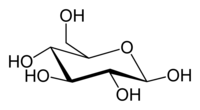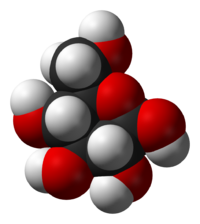Glucose
2008/9 Schools Wikipedia Selection. Related subjects: Chemical compounds
| Glucose | |
|---|---|
 |
|
 |
|
| IUPAC name | 6-(hydroxymethyl)oxane -2,3,4,5-tetrol OR (2R,3R,4S,5R,6R)-6-(hydroxymethyl)tetrahydro-2H-pyran-2,3,4,5-tetraol |
| Identifiers | |
| CAS number | 50-99-7 (D-glucose) 921-60-8 (L-glucose) |
| SMILES | C(C1C(C(C(C(O1)O)O)O)O)O |
| Properties | |
| Molecular formula | C6H12O6 |
| Molar mass | 180.16 g mol−1 |
| Density | 1.54 g cm−3 |
| Melting point |
α-D-glucose: 146°C |
| Except where noted otherwise, data are given for materials in their standard state (at 25 °C, 100 kPa) Infobox disclaimer and references |
|
Glucose (Glc), a monosaccharide (or simple sugar), is an important carbohydrate in biology. The living cell uses it as a source of energy and metabolic intermediate. Glucose is one of the main products of photosynthesis and starts cellular respiration in both prokaryotes and eukaryotes. The name comes from the Greek word glykys (γλυκύς), which means "sweet", plus the suffix "-ose" which denotes a sugar.
Two stereoisomers of the aldohexose sugars are known as glucose, only one of which (D-glucose) is biologically active. This form (D-glucose) is often referred to as dextrose monohydrate, or, especially in the food industry, simply dextrose (from dextrorotatory glucose). This article deals with the D-form of glucose. The mirror-image of the molecule, L-glucose, cannot be metabolized by cells in the biochemical process known as glycolysis.
Glucose is commonly available in the form of a white substance or as a solid crystal. It can also be commonly found as an aqueous solution.
Structure
Glucose (C6H12O6) contains six carbon atoms, one of which is part of an aldehyde group, and is therefore referred to as an aldohexose. In solution, the glucose molecule can exist in an open-chain (acyclic) and ring (cyclic) form (in equilibrium), the latter being the result of a covalent bond between the aldehyde C atom and the C-5 hydroxyl group to form a six-membered cyclic hemiacetal. At pH 7 the cyclic form is predominant. In the solid phase, glucose assumes the cyclic form. As the ring contains five carbon atoms and one oxygen atom, which resembles the structure of pyran, the cyclic form of glucose is also referred to as glucopyranose. In this ring, each carbon is linked to a hydroxyl side group with the exception of the fifth atom, which links to a sixth carbon atom outside the ring, forming a CH2OH group.
Isomers
Aldohexose sugars have 4 chiral centers giving 24 = 16 stereoisomers. These are split into two groups, L and D, with 8 sugars in each. Glucose is one of these sugars, and L and D-glucose are two of the stereoisomers. Only 7 of these are found in living organisms, of which D-glucose (Glu), D- galactose (Gal) and D- mannose (Man) are the most important. These eight isomers (including glucose itself) are all diastereoisomers in relation to each other and all belong to the D-series.
An additional asymmetric centre at C-1 (called the anomeric carbon atom) is created when glucose cyclizes and two ring structures, called anomers are formed — α-glucose and β-glucose. These anomers differ structurally with respect to the relative positioning of their hydroxyl group linked to C-1 and the group at C-6, which is termed the reference carbon. When D-glucose is drawn as a Haworth projection or in the standard chair conformation, the designation α means that the hydroxyl group attached to C-1 is positioned trans to the -CH2OH group at C-5, while β means it is cis. Another popular method of distinguishing α from β is by observing whether the C-1 hydroxyl is below or above the plane of the ring, respectively, but this method is an inaccurate definition and may fail if the glucose ring is drawn upside down or in an alternative chair conformation. The α and β forms interconvert over a timescale of hours in aqueous solution, to a final stable ratio of α:β 36:64, in a process called mutarotation.
Rotamers
Within the cyclic form of glucose, rotation may occur around the O6-C6-C5-O5 torsion angle, termed the ω-angle, to form three rotamer conformations as shown in the diagram below. Referring to the orientations of the ω-angle and the O6-C6-C5-C4 angle the three stable staggered rotamer conformations are termed gauche-gauche (gg), gauche-trans (gt) and trans-gauche (tg). For methyl α-D-glucopyranose at equilibrium the ratio of molecules in each rotamer conformation is reported as 57:38:5 gg:gt:tg. This tendency for the ω-angle to prefer to adopt a gauche conformation is attributed to the gauche effect.
Production
Natural
- Glucose is one of the products of photosynthesis in plants and some prokaryotes.
- In animals and fungi, glucose is the result of the breakdown of glycogen, a process known as glycogenolysis. In plants the breakdown substrate is starch.
- In animals, glucose is synthesized in the liver and kidneys from non-carbohydrate intermediates, such as pyruvate and glycerol, by a process known as gluconeogenesis.
Commercial
Glucose is produced commercially via the enzymatic hydrolysis of starch. Many crops can be used as the source of starch. Maize, rice, wheat, potato, cassava, arrowroot, and sago are all used in various parts of the world. In the United States, cornstarch (from maize) is used almost exclusively.
This enzymatic process has two stages. Over the course of 1-2 hours near 100 °C, enzymes hydrolyze starch into smaller carbohydrates containing on average 5-10 glucose units each. Some variations on this process briefly heat the starch mixture to 130 °C or hotter one or more times. This heat treatment improves the solubility of starch in water, but deactivates the enzyme, and fresh enzyme must be added to the mixture after each heating.
In the second step, known as "saccharification", the partially hydrolyzed starch is completely hydrolyzed to glucose using the glucoamylase enzyme from the fungus Aspergillus niger. Typical reaction conditions are pH 4.0–4.5, 60 °C, and a carbohydrate concentration of 30–35% by weight. Under these conditions, starch can be converted to glucose at 96% yield after 1–4 days. Still higher yields can be obtained using more dilute solutions, but this approach requires larger reactors and processing a greater volume of water, and is not generally economical. The resulting glucose solution is then purified by filtration and concentrated in a multiple-effect evaporator. Solid D-glucose is then produced by repeated crystallizations.
Function
We can speculate on the reasons why glucose, and not another monosaccharide such as fructose (Fru), is so widely used in evolution, the ecosystem, and metabolism. Glucose can form from formaldehyde under abiotic conditions, so it may well have been available to primitive biochemical systems. Probably more important to advanced life is the low tendency of glucose, by comparison to other hexose sugars, to non-specifically react with the amino groups of proteins. This reaction ( glycation) reduces or destroys the function of many enzymes. The low rate of glycation is due to glucose's preference for the less reactive cyclic isomer. Nevertheless, many of the long-term complications of diabetes (e.g., blindness, kidney failure, and peripheral neuropathy) are probably due to the glycation of proteins or lipids. In contrast, enzyme-regulated addition of glucose to proteins by glycosylation is often essential to their function.
Glucose in glycolysis
|
||||||||||||||||||||
| Compound C00031 at KEGG Pathway Database. Enzyme 2.7.1.1 at KEGG Pathway Database. Compound C00668 at KEGG Pathway Database. Reaction R01786 at KEGG Pathway Database. | ||||||||||||||||||||
Use of glucose as an energy source in cells is via aerobic or anaerobic respiration. Both of these start with the early steps of the glycolysis metabolic pathway. The first step of this is the phosphorylation of glucose by hexokinase to prepare it for later breakdown to provide energy.
The major reason for the immediate phosphorylation of glucose by a hexokinase is to prevent diffusion out of the cell. The phosphorylation adds a charged phosphate group so the glucose 6-phosphate cannot easily cross the cell membrane. Irreversible first steps of a metabolic pathway are common for regulatory purposes.
As a precursor
Glucose is critical in the production of proteins and in lipid metabolism. Also, in plants and most animals, it is a precursor for vitamin C (ascorbic acid) production. It is modified for use in these processes by the glycolysis pathway.
Glucose is used as a precursor for the synthesis of several important substances. starch solution Starch, cellulose, and glycogen ("animal starch") are common glucose polymers ( polysaccharides). Lactose, the predominant sugar in milk, is a glucose- galactose disaccharide. In sucrose, another important disaccharide, glucose is joined to fructose. These synthesis processes also rely on the phosphorylation of glucose through the first step of glycolysis.



